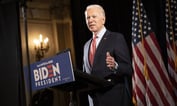Any economy growing at a 33% rate can comfortably claim it’s soaring through the jet stream. When it’s the U.S. economy, a $20 trillion juggernaut that is the world’s largest, that figure is jaw-dropping. Yet on Thursday, the Bureau of Economic Analysis reported just that, announcing that the U.S. economy’s third-quarter growth rate was the most explosive since at least World War II. That’s welcome news for workers and families struggling to navigate Covid-19, for the business community and for everyone else who depends on a vibrant economy.
It also offers President Donald Trump an opportunity to tout great economic news and claim responsibility for steering everything in this happy direction. A presidential election is just days away, and a big, juicy GDP number is welcome campaign fodder. In fact, Trump’s campaign has already run ads anticipating the BEA’s release; “THE HIGHEST GDP IN AMERICAN HISTORY” and “Thanks to President Trump the US economy is only going UP!” were two of the slogans.
Those are wild exaggerations, however, even for Trump and even by the standards of campaign bravado. For one, the economy didn’t actually grow 33%. As our Bloomberg Opinion colleague Justin Fox helpfully explained on Wednesday, headline GDP growth is an annual rate — meaning GDP grew by roughly a fourth of the reported amount in the third quarter, or closer to 7.4%. That’s still the largest one-quarter growth since the BEA data series begins in 1947, but it also follows the largest decline on record: a plunge of more than 10% in the first half of this year. So even after an encouraging third quarter, GDP is still down 3.6% since the pandemic began, marking one of the most severe postwar contractions.
What’s behind the boffo growth numbers? Some good fortune and lots of help from taxpayers and the federal government were at work.
Congress and the Federal Reserve came together in March to engineer a $7 trillion bailout that kept millions of workers on payrolls through the summer, and many more unemployed Americans housed and fed. It also allowed financial markets to keep operating smoothly and provided a generous cushion beneath struggling corporations and small businesses. And Covid-19, the specter haunting the economy all year, eased its onslaught a bit in August and September, possibly giving consumers more courage to venture out.
Those tailwinds are fading, however. Fed Chair Jerome Powell has committed to doing everything possible to support the economy, but the Fed can do only so much, which is why Powell has urged Congress to provide more federal aid. Rather than answer that call, Congress has dithered for weeks over the size of the next bailout, with Republicans refusing to put a meaningful relief package on the table. Lawmakers are now on hiatus until after the election, so more relief will take weeks or months to arrive, if it ever does.
Meanwhile, the coronavirus has reasserted itself across the country, again threatening lives, families, the economy and jobs. All of that points to slower growth ahead, if not further economic contraction.
Indeed, the economy is already slowing. One drawback of GDP calculations is that they are measured quarterly and reported with nearly a month’s lag, so they don’t provide the timeliest assessment. One way around that is to look at economic gauges that are compiled more frequently. And many of them show an economy that slowed significantly during the third quarter.









 October 29, 2020 at 04:47 PM
October 29, 2020 at 04:47 PM











